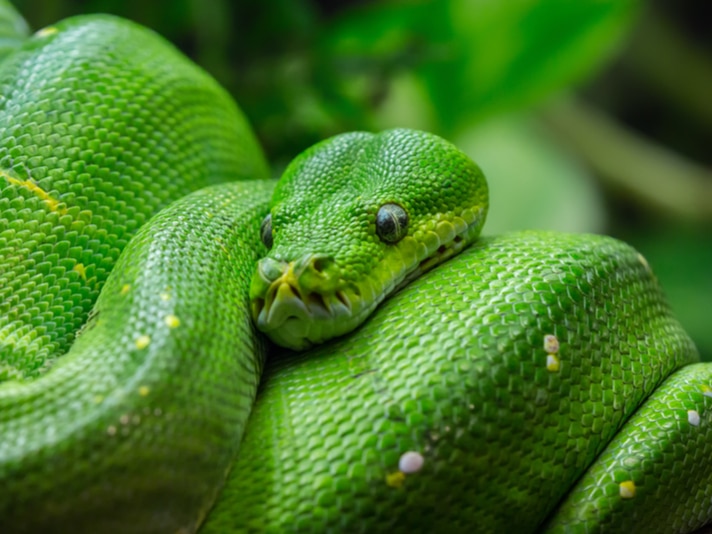The green tree python is an exquisite snake that never fails to fascinate.
The green tree python (Morelia viridis) is one of the most fascinating and colorful snakes enjoyed by herpetoculturists. Often referred to by hobbyists and breeders as the “chondro,” based on the snake’s original genus of Chondropython, this small to medium-sized arboreal species is indigenous to New Guinea and some of the surrounding islands, as well as the Cape York Peninsula of northern Australia. This slender snake often appears smaller than it actually is, due to its habit of perching on a branch in a compact, inner-looped posture. Adults average 4 to 5 feet in length, but can exceed 6 feet. Highly nocturnal, green tree pythons seldom move during daylight hours, and combined with its beautiful colors, this makes this python a less-threatening snake to encounter for people who are unaccustomed to captive snakes.
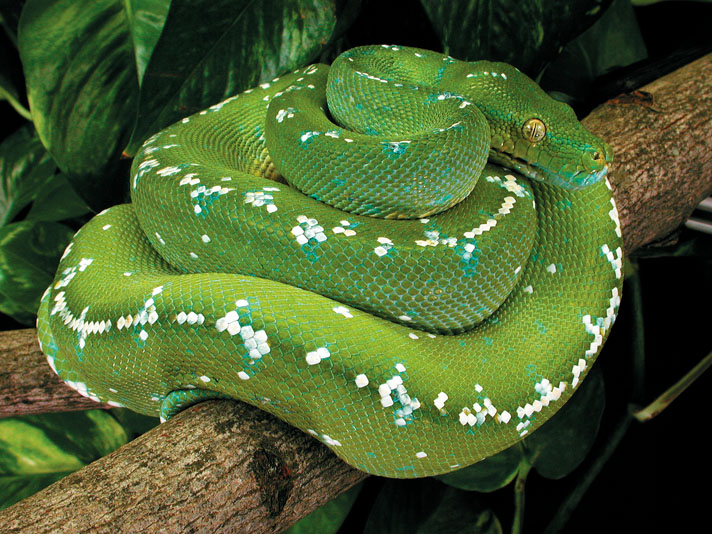
Greg Maxwell
The Aru Island green tree pythons are known for their white dorsal markings and bluish belly.
The Most Beautiful Pythons
Chondros can occupy a wide range of habitats, from lowland scrub to montane forests. Several geographic races have been described, each having somewhat distinct appearance and size differences. These include the island forms of Aru and Biak, mainland New Guinea, and the Cape York race. Some keepers claim “locality” distinctions among the mainland forms but there is some controversy associated with this. Certainly the highly variable coloration and patterns associated with green tree pythons make specific locality identification an inexact science unless proper documentation can be provided.
It is this variability that makes green tree pythons so highly sought after as pets. Neonates are yellow or maroon when they hatch, and undergo a color change when they are about a year old. Wild adult specimens are typically green, as the common name implies. However, most have at least a small amount of secondary coloration. Blue, yellow, white and black are the most common, with some specimens exhibiting an unusual quantity of one or more of these colors. Occasionally, a nearly solid blue or yellow animal is observed. Breeders have taken advantage of this variability and have worked to develop captive bloodlines that strengthen specific color traits. Others prefer the more naturally occurring color patterns and are working to preserve these traits in captive-bred lines.
Unlike the popular ball python, green tree python color traits are not the result of simple dominant and recessive genes. For example, most hobbyists understand that when two ball pythons having specific traits are bred together, they will produce fairly predictable results. As more traits are developed through selective breeding, many reliable color and pattern morphs are brought to market.
Chondro color morphs, on the other hand, tend to be random and unpredictable. Breeding two adults with high amounts of blue, for example, can yield great results or disappointing ones. Only after working with specific bloodlines over time can a breeder have an increased degree of confidence in the resulting offspring. Happily, such selective breeding projects often produce results. Because many such projects are now well established, color morphs that were once extremely rare are much more readily available. High blue, high yellow, calico and melanistic green tree pythons are among the popular varieties available to hobbyists.
Captive-Bred Green Tree Pythons Are Best
Some green tree pythons have a reputation for being difficult captives that are aggressive and hard to handle, but these stereotypes are largely untrue of captive-bred specimens. While it is a fact that imported adults seldom thrive in captivity and are usually snappy, captive-bred chondros are not difficult to maintain once their basic needs are understood and met. Chondros aren’t for everyone — they do have some specialized requirements — but hobbyists who care enough to arm themselves with the necessary knowledge and are willing to make the effort to provide this unique species with the correct captive environment can expect to have success.
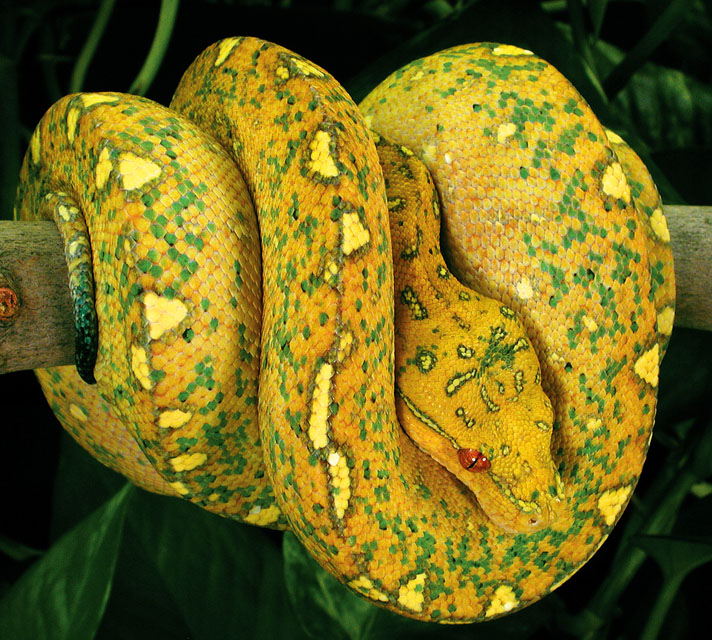
Greg Maxwell
This is a 2-year-old male Biak outcross. Biak chondros are noted for their large size, mottled yellow coloration, large heads and nasty tempers.
Most captive-bred green tree pythons can be safely free-handled during daylight hours. There are exceptions, and individuals of the Biak race tend to be irritable. Babies under a year in age should not be handled unless absolutely necessary as they are very fragile and usually quite nervous. These exceptions aside, the majority of captive-bred chondros tame very nicely as they mature and some are quite docile. As with any reptile, allow each individual animal to dictate if and when it should be held. If you want a snake that can be handled quite frequently, there are other small boids and pythons that make a better choice, such as the ball python.
I have repeatedly mentioned the benefits of captive-bred pythons, and this is intentional. Perhaps the single most important element related to successfully keeping green tree pythons is obtaining true captive-bred snakes. The reasons for this are many. Imported specimens are usually traumatized, parasitized and dehydrated. Furthermore, they are frequently imported illegally. They come without documentation regarding origin or feeding history, and most are stressed and ill tempered. The majority of imported chondros perish in less than two years and seldom reproduce. On top of all this, purchasing imports helps to support a trade that negatively impacts wild populations.
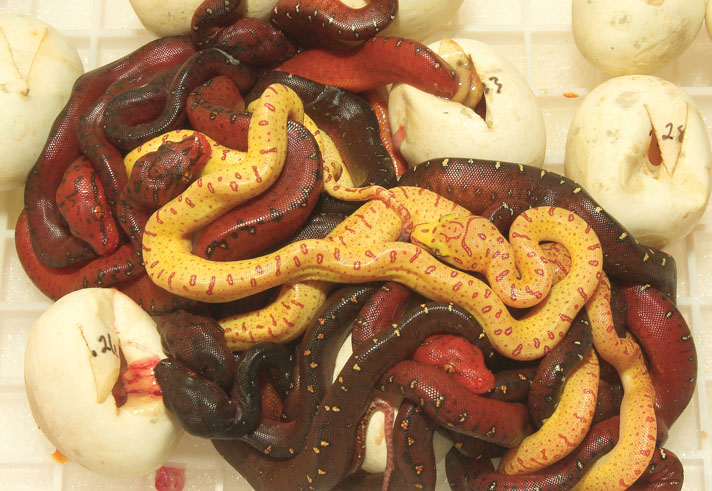
greg maxwell
This clutch of babies produced by the author exhibits the wide color and pattern variety related to the depth of genetic diversity in the parents.
Captive-bred specimens, by contrast, are almost always well acclimated to captivity. They are parasite free, come with bloodline histories and feeding records, and are accustomed to interacting with people. Captive-bred chondros are usually fairly long lived, with many specimens living to be older than 10 years of age. In fact, it is not unheard of for males to reach double this age; one of my males lived to be 16 years old. Females can also live a long time, but most are doing well to live past 10 years in my experience. It is best to obtain yearling or young adult green tree pythons because neonates are very fragile and can be tricky to feed.
By buying captive bred snakes, you are helping to support hard-working breeders who are committed to your success and to the best interests of the animals. Locating authentic captive-bred chondros can be more difficult than you think because many people selling them will tell you that their animals are captive bred! Learning to recognize imported animals is relatively easy with a bit of experience, however. Imports look thin and usually have some scars related to their life in the wild. Captive-bred green tree pythons will have good body weight and should be free of any blemishes. Anyone offering true captive-bred (not “farm-bred”) chondros will be able to tell you about the breeder and will have records of the parents, including photos. If they don’t, it is best to find another source.
Breeding Green Tree Pythons
Green tree pythons represent a unique challenge to potential breeders. For the best chance at success, start with captive-bred adults that are from basic bloodlines. Most of the specialized color morphs have been developed by controlled inbreeding, and animals from these projects may have decreased fertility.
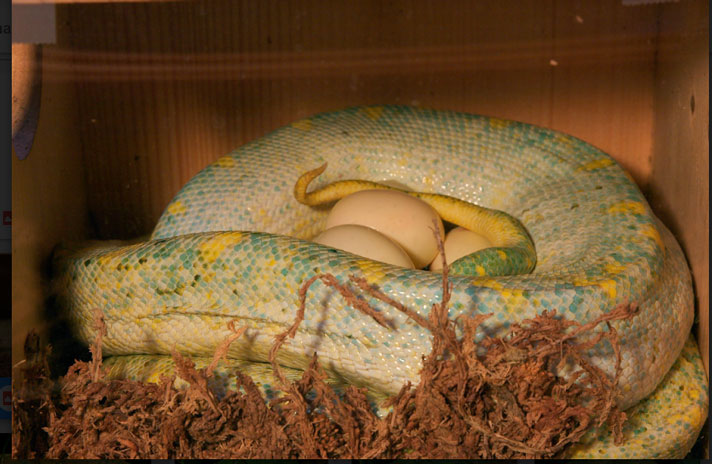
greg maxwell
A female chondro laying her eggs in a wooden nest box.
Males chondros can breed at 2 years of age but it is best to wait until females are 3 years old and at least 1,000 grams in weight before breeding is attempted. Condition breeder females by increasing feeding frequency to add body weight. Don’t overdo it, though; the goal is some extra fat reserves, not obesity. Males can be fed a few extra meals also in preparation for fasting.
Thermally cycle both male and female green tree pythons by dropping temperatures at night down to 68 degrees or so, while providing normal daytime cage temps with a basking area of 88 degrees. After a few weeks of cycling, introduce the male into the female’s cage in the late afternoon. Make sure the pair is compatible; copulations will take place every few days if both animals are receptive.
Females will go off feed as they develop ripening follicles. An ovulation event of 24 to 48 hours in duration marked by localized swelling and posture shifting will take place if things are progressing correctly. A pre-laying shed is usually recorded two to three weeks prior to egg deposition. Restore heat to females once they have ovulated.
Green tree python eggs can be incubated maternally or artificially. There are various techniques for successfully incubating the eggs, and most breeders do so at a temperature of 86 to 88 degrees. Eggs typically hatch after 49 to 52 days. Hatchlings are usually housed in plastic tubs with small perches. It is crucial to keep neonates well hydrated. Begin offering them pinky mice after their first sheds.
The Best Green Tree Python Enclosure
Before you obtain your beautiful, captive-bred green tree python, you will want to have a cage or vivarium set up and fully functioning with the temperature and humidity levels regulated. Resist making an impulse purchase before you are ready to adequately care for such a specialized herp. The time to work out the details of cage performance is before, not after, acquiring an occupant! Your new chondro will have the best start in your home when you prepare ahead for its arrival. Like most reptiles, green tree pythons have specific environmental needs. With a bit of effort, these are not difficult to provide. The basic considerations when designing a good cage for a yearling or adult chondro include size and shape, ability to hold heat and humidity, and visibility and access. Let’s discuss each of these in order.
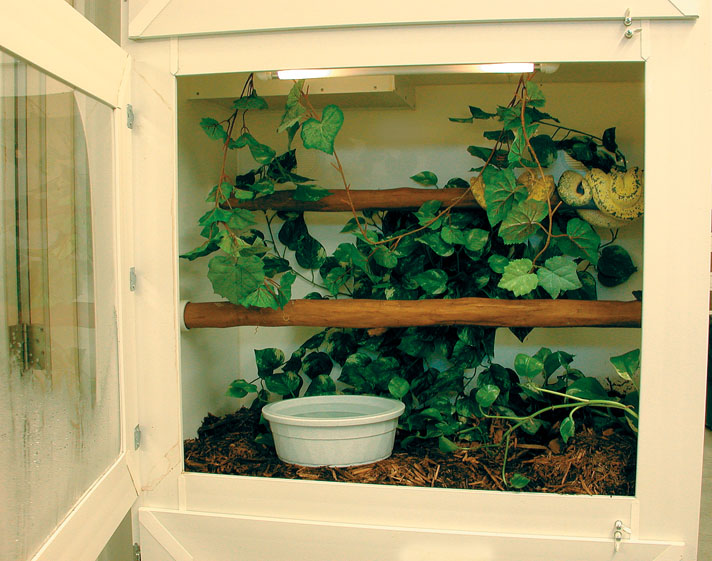
Greg Maxwell
An ideal chondro cage setup with horizontal aspect ratio, top-mounted heat panel controlled by a thermostat to establish a thermal gradient, sturdy branches, silk hanging plants for cover, water bowl, sliding glass front, and absorbent cypress mulch substrate.
While green tree pythons can be successfully kept in smaller cages, I recommend one that’s at least 36 inches wide, 24 inches tall, and 18 to 24 inches deep. Smaller cages tend to inhibit the establishment of thermal gradients and also contribute to lethargy in the animals. I also prefer a cage that is longer than it is tall. Vertically oriented cages are commonly recommended for arboreal reptiles, and certainly these can be used with chondros, but in my experience, most green tree pythons will perch in the tallest part of the cage and ignore a vertical thermal gradient. In a horizontal cage, a thermal gradient can be provided that the snakes will actually use.
This leads to the next important element of cage function, which is the enclosure’s ability to hold both heat and humidity. Green tree pythons come from regions of relatively high humidity, and they need a cage made from materials that won’t deteriorate from contact with moisture. At the same time, the cage must be made of thermally efficient materials in order to retain heat.
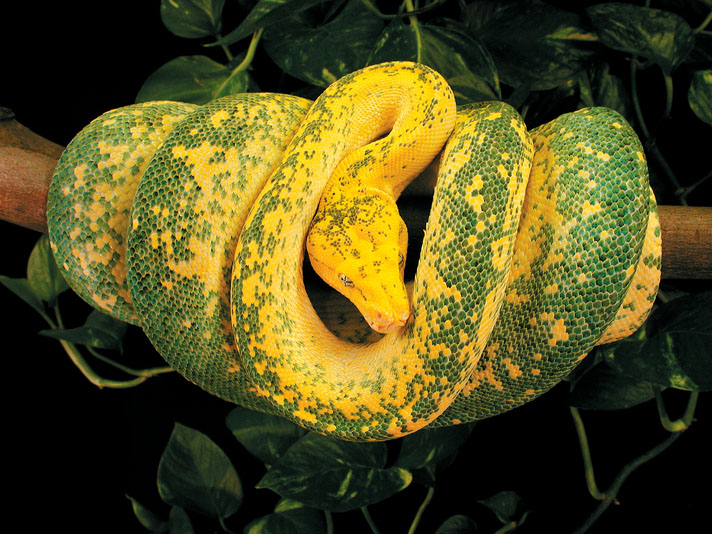
greg maxwell
This high-yellow female chondro is descended from the “lemon tree” bloodline.
Obviously glass and plastic are waterproof and will hold up well in a humid environment, but glass and many types of plastic cages lose heat quickly unless the room they’re in is also heated. Double-walled plastic can work well. Wooden cages hold heat efficiently but can grow mold and will deteriorate over time unless they are sealed. My chondro cages were made using a material called MDF (medium-density fiberboard, available at stores such as Home Depot, etc.) that I lined with adhesive-backed, waterproof vinyl. The interior cage corners were sealed with silicone. The result was a waterproof cage that held heat very well.
The best source of heat for your green tree python is a thermostatically controlled radiant heat panel mounted in the top of the cage and over one end. The cage should be fitted with sturdy perches about the same diameter as the occupant and located in the upper third of the cage. (I like real wood branches and so do the snakes.) This makes establishing a thermal gradient with a warm basking area easy. I like a gradient of about 78 degrees Fahrenheit on the cool side and a basking area of about 88 degrees under the heat panel. In my experience, most chondros position themselves in the area along the gradient with an average temp of about 84 degrees.
Humidity can be maintained by daily light misting of the interior of the cage and substrate, which can be newspaper or any kind of absorbent bedding, such as cypress mulch, that is safe for reptiles. Don’t keep a chondro cage soaking wet! Remember that humidity is the measure of water vapor in the air, not how wet the cage or substrate is. Another option is to simply humidify the entire room in which your chondro’s enclosure is kept. If your snake is able to shed without difficulty then the humidity is about right. If not, increase the humidity.
Fresh drinking water should always be provided in a bowl on the cage floor. Chondros will also often drink water droplets off of themselves after being misted, but avoid spraying water directly onto opaque snakes that are preparing to shed. Enough ventilation should be provided so that the cage does not stay constantly wet, but limited enough that it doesn’t dry out rapidly.
Of course we want to look at our green tree pythons because they are so beautiful! Cages with sliding glass fronts make visibility and controlled accessibility easy. Hinged doors can also work, but require opening the entire cage front when cleaning and feeding. Chondros feel more secure when they have some hanging plants to provide cover, too, and some are ill at ease when exposed in a bare cage. Silk plants look great and are easy to clean.
If you choose to use cage lighting, be aware that lights can raise the temperature in the cage significantly. Green tree pythons do not need special lighting and, in fact, do require darkness for eight to 10 hours at night. Using a timer to regulate the photoperiod is a good idea.
What To Feed Green Tree Pythons
Most green tree pythons are ravenous eaters, and even the most placid chondro can turn into an aggressive feeding machine as dusk approaches! Always use frozen-thawed rodents, never live. It is a rare chondro that insists on live prey, and with it there is always a risk to the snake. Soak a frozen rodent in hot water to thaw it, and offer it warm and wet to the snake. Green tree pythons have heat-sensitive labial pits along their mouths that help them to detect warm prey, and the snakes respond very well to thawed rodents that are still warm. Use long tongs or hemostats to offer food, lest your own hand provide the heat signature with a possible bite resulting.
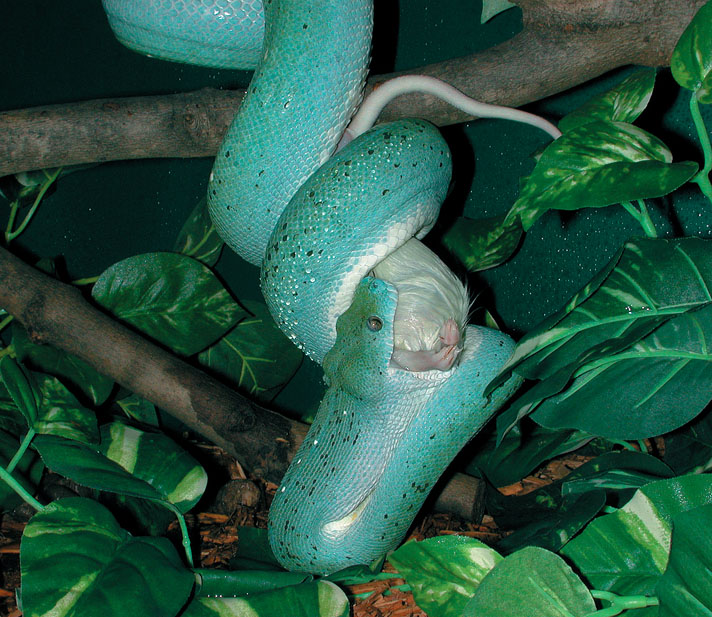
greg maxwell
Soak a frozen rodent in hot water to thaw it, and offer it warm and wet to the snake.
Yearling chondros can safely be fed weekly. Offer a mouse large enough to result in a noticeable swelling of the snake’s body. Avoid feeding a huge meal that makes the young snake appear bloated. I recommend keeping meal sizes small and limiting the frequency of feeding for adult animals to a meal every 10 to 12 days. Rat pups about the same size as the snake’s body work well, even though adult green tree pythons are capable of accepting larger food items.
Because keepers enjoy feeding time almost as much as the snakes do, it is easy to overfeed green tree pythons. Overfeeding adults leads to lethargy and obesity, which contribute to health issues such as rectal prolapse. Allowing your animals to become hungry between feedings encourages activity and stimulates regular defecations.
It is not uncommon for green tree pythons to undergo seasonal fasting, even if they are not being thermally cycled for breeding (see sidebar). This is especially true for males, most of which will go off feed for weeks and sometimes months, beginning in late summer or fall. Novice chondro keepers can become frantic over this, but there is seldom any need to worry. The snakes will resume feeding when they are ready, and as long as the other parameters related to proper care and environment are met, they will be just fine. Keeping a single male with no females around and preventing the cage from being exposed to diminishing daylight hours outside may help in avoiding seasonal fasting, but regardless, seasonal fasting is a fact of life that must be accepted if you’re going to keep green tree pythons.
Maintaining green tree pythons in captivity is not too difficult. While they do require a more specialized setup than other commonly kept herps such as corn snakes or ball pythons, they are more than worth the effort. Their splendid colors and arboreal way of life strongly appeal to hobbyists and breeders who are drawn to work with an exotic species. While the challenge is greater, so are the rewards.
Chondros are addictive, and most keepers find that they can’t have just one. If you have been considering getting one, I encourage you to acquire all the information you can. Talk with other keepers and breeders, and learn about the animals in person from those who are experienced and willing to help you get the best start. Do this, and you will be in for a rewarding experience, indeed!
Greg Maxwell was a commercial green tree python breeder for 12 years. He developed the calico color/pattern morph, co-founded the ChondroWeb Forums and is the author of The Complete Chondro (ECO publishing, 2003) and The More Complete Chondro (2005). He currently resides in Kansas City, Mo., and builds custom acoustic guitars. Check out his work at dogwoodguitars.com and on his Facebook page, Dogwood Guitars and Lutherie.

